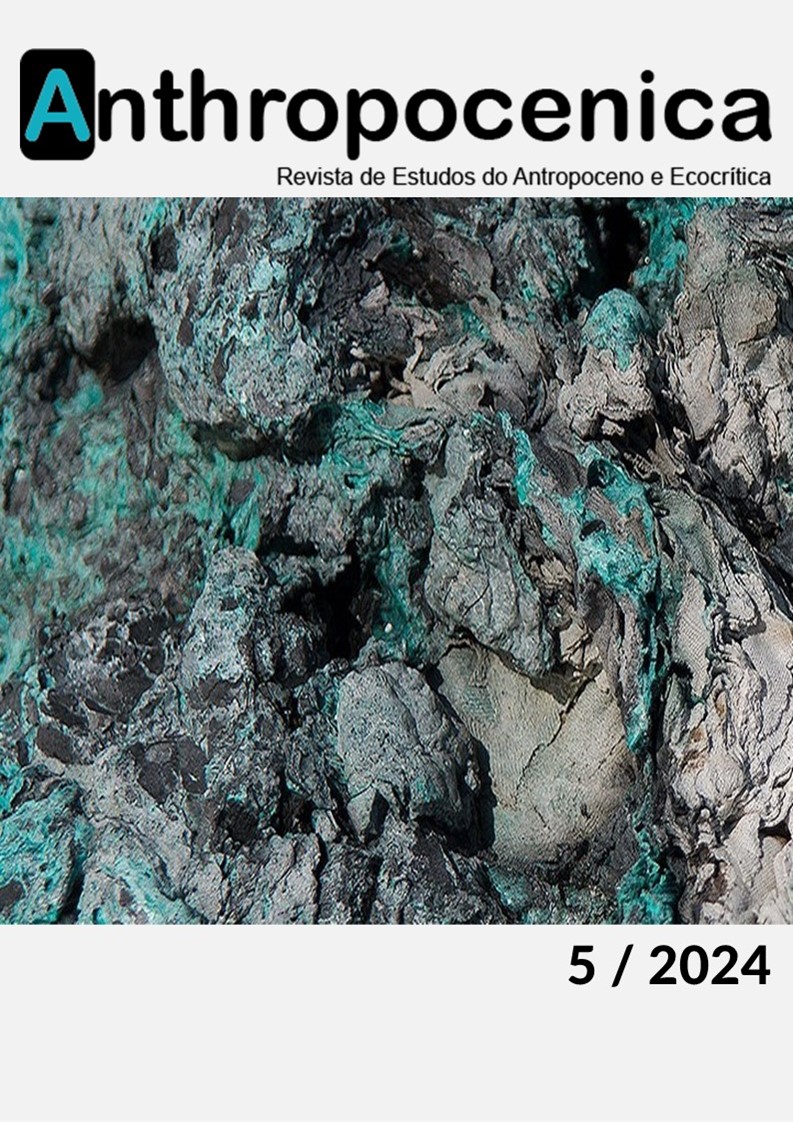The human condition in the Anthropocene-four chakrabartian parallaxes
DOI :
https://doi.org/10.21814/anthropocenica.6024Mots-clés :
Condition humaine, Anthropocène, Dipesh Chakrabarty, Parallaxe.Résumé
L'Anthropocène marque une époque cruciale où l'activité humaine est devenue la force dominante qui façonne la géologie et les écosystèmes de la Terre. Ce changement nécessite une réévaluation profonde de ce que signifie être humain. Cet article examine le concept de la "condition humaine" dans le cadre de l'Anthropocène, en s'appuyant sur les perspectives philosophiques de Dipesh Chakrabarty. L'article est organisé en deux parties principales. La première partie définit le sens de la "condition humaine", en la situant dans un contexte philosophique et historique plus large. La deuxième partie explore comment l'Anthropocène a transformé notre compréhension de la condition humaine, modifiant les perspectives traditionnelles sur l'agency humaine, la temporalité et l'impact planétaire. À travers cette analyse, de nouvelles perspectives sont proposées sur les dimensions existentielles et éthiques de l'être humain à une époque marquée par une profonde transformation écologique.
Téléchargements
Références
Baudrillard, J. (1983). Les strategies fatales. Bernard Grasset.
Bonneuil, C. (2023, March 30). Le global et le planétaire: À propos de Dipesh Chakrabarty, Après le changement climatique, penser l’histoire. Gallimard. https://laviedesidees.fr/IMG/pdf/20230310_chakra.pdf
Chakrabarty, D. (2016 [2015]). The human condition in the Anthropocene (Yale University, 18-19 February 2015). In M. Matheson (Ed.), The Tanner Lectures on Human Values (Vol. 35, pp. 137-188). University of Utah Press.
Chakrabarty, D. (2021). The climate of history in a planetary age. University of Chicago Press.
Chakrabarty, D. (2021a). Introduction. In D. Chakrabarty, The climate of history in a planetary age (pp. 1-20). University of Chicago Press.
Chakrabarty, D. (2021b). Toward an Anthropological Clearing. In D. Chakrabarty, The climate of history in a planetary age (pp. 182-204). University of Chicago Press.
Chakrabarty, D. (2021c). Postscript: The Global Reveals the Planetary. A Conversation with Bruno Latour. In D. Chakrabarty, The climate of history in a planetary age (pp. 205-217). University of Chicago Press.
Chakrabarty, D. (2021 [2009]). Four Theses. In D. Chakrabarty, The climate of history in a planetary age (pp. 13-48). University of Chicago Press.
Chakrabarty, D. (2021 [2018]). Anthropocene Time. In D. Chakrabarty, The climate of history in a planetary age (pp. 155-181). University of Chicago Press.
Chakrabarty, D. (2021 [2019]). The Planet: An Emergent Humanist Category. In D. Chakrabarty, The climate of history in a planetary age (pp. 68-92). University of Chicago Press.
Chakrabarty, D. (2023). One Planet, Many Worlds: The Climate Parallax. Brandeis University Press.
Clark, N. & Szerszynski, B. (2021). Planetary Social Thought. The Anthropocene Challenge to the social sciences. Polity Press.
Crutzen, P. J., & Stoermer, E. F. (2000). The “Anthropocene.” Global Change Newsletter, 41, 17-18.
Daintith, J. & Gould, W. (Eds.). (2005). The Facts on File Dictionary of Astronomy (5th ed.). Facts on File.
Descartes, R. (1966 [2019]). Discours de la méthode. Garnier-Flammarion.
Ebbesen, D. K., & Olsen, J. (2023). Exploring the Preconditions for a Developmental Science: Hegelian Metaphysics and Dialectics. Human Arenas, 6(2): 328-342. https://doi.org/10.1007/s42087-021-00210-5
Haraway, D. (2015). Anthropocene, Capitalocene, Plantationocene, Chthulucene: Making kin. Environmental Humanities, 6(1), 159-165.
Kagan, J. (2009). The three cultures: Natural sciences, social sciences, and the humanities in the 21st century. Cambridge University Press.
Lewis, S. L., & Maslin, M. A. (2015). Defining the Anthropocene. Nature, 519(7542), 171-180.
Mendes, J. (2023). Thinking Planetary Thinking. Filozofia, 78, Supplement “Philosophical Examinations of the Anthropocene”, 24-37.
Montaigne, M. E. de. (1993 [1580]). Essays (J. M. Cohen, Trans.). Penguin Books.
Montaigne, M. E. de. (1595). Essais, éd. Posthume (établi par Pierre de Brach et Marie de Gournay). Abel L'Angelier.
Moore, J. W. (2017). The Capitalocene, Part I: On the nature and origins of our ecological crisis. The Journal of Peasant Studies, 44(3), 594-630.
Ortega y Gasset, J. (1964 [1939]). Meditación de la técnica. In J. Ortega y Gasset, Obras completas, Tomo V (1933-1941) (6th ed., pp. 317-375). Revista de Occidente.
Präkel D. (2009). The Visual Dictionary of Photography. AVA Publishing
Sartre, J.-P. (1946). L'existentialisme est un humanisme. Les Editions Nagel.
Sartre, J.-P. (2007 [1946]). Existentialism is a humanism (C. Macomber, Trans.; A. Cohen-Solal, Intro.; S. Elkind-Sartre, Notes & Preface; J. Kulw, Ed.). Yale University Press.
Snow, C. P. (1959). The two cultures. Cambridge University Press.
Steffen, W., Broadgate, W., Deutsch, L., Gaffney, O., & Ludwig, C. (2015). The trajectory of the Anthropocene: The Great Acceleration. The Anthropocene Review, 2(1), 81-98.
Stoppani, A. (1873). Corso di geologia (vol. 2: Geologia stratigrafica). Bernardoni e Brigola.
Wenders, W. (Director). (1987). Der Himmel über Berlin [Film]. Road Movies.
Weisman, A. (2007). The world without us. Thomas Dunne Books/St. Martin's Press.
Wilson, E. O. (1998). Consilience: The unity of knowledge. Knopf.
Žižek, S. (2006). The parallax view. The MIT Press.
Žižek, S. (2023, January 23). A cancel culture parallax. Compact. https://www.compactmag.com/article/a-cancel-culture-parallax




